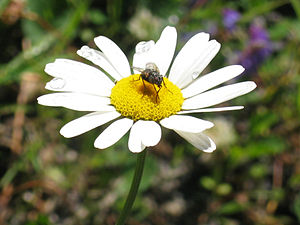Leucanthemum vulgare
| Oxeye daisy | |
|---|---|
 | |
| Binomial: | Leucanthemum vulgare |
| Family: | Asteraceae |
| Type: | herbaceous perennial |
| Light requirements: | full sun |
| Bloom season: | spring |
The oxeye daisy (Leucanthemum vulgare, syn. Chrysanthemum leucanthemum) also known as the marguerite is a widespread flowering plant native to Europe and the temperate regions of Asia. It is one of a number of plants to be called by the common name daisy. It is also sometimes called moon daisy or dog daisy.
Description
[edit | edit source]It is a perennial prostrate herb with small flower head (not larger than 5 cm) that consists of about 20 white ray flowers and numerous yellow disc flowers, growing on the end of the stem. The stem is mostly unbranched and sprouts laterally from a creeping rootstock.
The leaves are darkgreen on both sides. The basal and middle leaves are petiolate, obovate to spoon-shaped, and serrate to dentate. The upper leaves are shorter, sessile and borne along the stem.
It produces an abundant number of flat seeds without pappus. It spreads also vegetatively by rooting underground stems.
Growing Conditions
[edit | edit source]Varieties
[edit | edit source]Uses
[edit | edit source]The oxeye daisy is a typical meadow flower, growing in a variety of plant communities such as dry fields, meadows, but also under scrubs, open-canopy forests and waste places. It thrives in a wide range of conditions and prefers heavy and damp soils. It was introduced in parts of North America, Australia and New Zealand, where it is now a common weed displacing native plant species in some areas. It is difficult to control or eradicate, since a new plant can regenerate from rhizome fragments. However, in North Carolina it is planted on roadsides by the highway department.[1]
The un-opened buds can be marinated and used in a similar way to capers.[2] The game "He loves me, he loves me not" ("effeuiller la marguerite" (in French)) is associated with this flower.
Maintenance
[edit | edit source]Propagation
[edit | edit source]Harvest
[edit | edit source]Pests and Diseases
[edit | edit source]References
[edit | edit source]- ↑ "Wildflowers Find Favor With Highway Gardeners" article by Felicity Barringer in the New York Times August 29, 2007
- ↑ Ox-eye Daisy Capers at Forbes wild foods. Retrieved December 12, 2006.
- Blanchan, Neltje (2005). Wild Flowers Worth Knowing. Project Gutenberg Literary Archive Foundation.
| Wikiversity is collecting bloom time data for Leucanthemum vulgare on the Bloom Clock |
Gallery
[edit | edit source]-
Leucanthemum vulgare
-
Ox-eye daisy Leucanthemum vulgare
-
Leucanthemum vulgare
-
Ox-eye daisies in Germany
-
Close-up of an ox-eye daisy with a spittlebug
-
A close-up of the flowers
- Book:Horticulture/Finder/Types/Plants, Herbaceous
- Book:Horticulture/Finder/Seasons/Spring
- Book:Horticulture/Finder/Special/Weedy or Aggressive
- Book:Horticulture/Finder/Lifetime/Perennial
- Book:Horticulture/Finder/Special/Quality Nectar Source
- Book:Horticulture/Finder/Invasive/North America
- Book:Horticulture/Finder/Native/Europe





